Eddy Current DefinitionEddy currents, also known as Foucault's currents in electromagnetism, are loops of electric current that are induced within conductors by a magnetic field that is changing within the conductor in accordance with Faraday's theory of induction or by the relative movement of a wire in a magnetic field. Tight loops of eddy currents go through conductors in directions opposite to the magnetic flux. By way of an AC electromagnet or transformer's time-varying magnetic field, for instance, or by the relative motion of a magnet and a neighboring conductor, they may be generated within nearby stationary conductors. The amplitude of the current inside a given loop varies inversely with the resistivity of the substance and is related to the magnetic field's strength, the loop's area, and the rate at which the flux changes. These circular currents in a piece of metal can be visualized on a graph and resemble eddies or vortexes in a liquid. 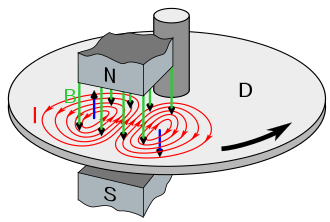
Lenz's law states that an eddy current generates a magnetic field that resists the modification of the magnetic field that caused it, causing eddy currents to react back on the magnetic field's origin. For instance, eddy currents generated by the magnetic field that moves will cause the neighboring conductive surface to produce a drag force on the moving magnet that resists its motion. In order to swiftly halt rotating power tools while they're turned off, eddy current brakes utilize this phenomenon. Moreover, energy is lost as heat inside the material as a result of the current that flows through the conductor's resistance. Since eddy currents are a source of electrical loss in alternating current (AC) inductance, transformers, electric generators and motors, and other AC machinery, it is necessary to utilize special construction to reduce them, such as multilayer magnetic cores or ferrite cores. Induction heating devices and furnaces employ eddy currents to heat items, and eddy current testing tools are used to find defects and cracks in metal components. The 25th Prime Minister of France, Fran�ois Arago (1786-1853), who was additionally a mathematician, physicist, and astronomer, was the first to observe eddy currents. He noted what is now known as rotatory magnetism in 1824 and the fact that almost all conductive bodies might be magnetized; Michael Faraday completed and clarified these observations (1791-1867). Lenz's law, which was first formulated by Emil Lenz in 1834, states that the direction of an induced current flow inside an object will be such that its magnetism would oppose the change in magnetic flux that created the current flow. A portion of the external electric field is partially canceled by the secondary field created by eddy currents, which causes some of the outside flux to escape the conductor. L�on Foucault (1819-1868), a French physicist, is credited with discovering eddy currents. In September 1855, he made the discovery that when a copper disc is rotated with its rim sandwiched between a magnet's poles, a stronger effort is needed to turn it, and the metal is also heated as a result of the eddy current created. When David E. Hughes applied the concepts to carry out metallurgical sorting tests in 1879, it was the first time eddy current was utilised for non-destructive testing. Properties of Eddy Current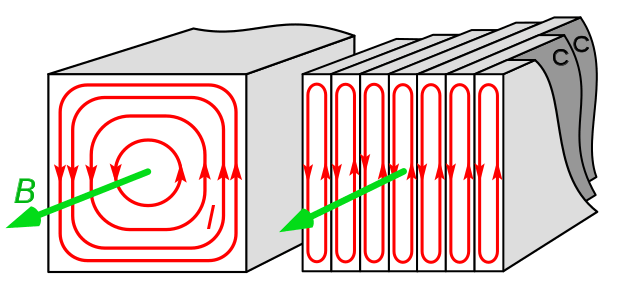
Electromagnetic forces and heat are produced by eddy currents in wires with non-zero resistance. Induction heating is possible with heat. Levitation, movement, or a powerful braking action can all be achieved using electromagnetic forces. Eddy currents may also cause harm, such as transformer power loss. In this usage, they are reduced through the use of thin plates, conductor lamination, or other conductor shape-related aspects. In conductors, the skin effect is caused by self-generated eddy currents. The other can be used to test materials without causing any damage to them in order to look for geometrical features like microcracks. The closeness effect, which is brought on by eddy currents that are externally created, has a similar impact. When the field, as well as the object, are stationary in relation to one another, an object or a portion of the object experience stable field strength and direction; otherwise, the field is unsteady because the conductor's shape prevents currents from flowing. These events result in charges building up on or inside the object, which produces static shock potentials that block any more current. Although static potentials may initially be produced as a result of currents, these potentials may only exist briefly. Certain sources of energy, like kinetic energy, are converted into heat via resistive losses caused by eddy currents. Electric motors, iron-core transformers, as well as other devices that utilize shifting magnetic fields are less efficient as a result of this Joule heating. These devices reduce eddy currents by employing ferrites as the magnetic core material, which has a low electrical conductivity, or by using laminations, which are thin magnetic sheets. Electrons are unable to travel in wide arcs because of the insulating space between the laminations. Similar to the Hall effect, charges build up at the edges of the laminations, creating electric fields that prevent any additional charge buildup and hence suppress the eddy currents. The reduction of eddy currents increases with the decrease in the distance among adjacent laminations, or more laminations in every unit area, parallel to the applied field. Although there are certain useful applications, it is not necessarily a bad thing when input energy is converted to heat. Eddy current brakes, which are seen in some railroad brakes, are one example. Eddy currents are produced in metal wheels when they are subjected to an electromagnet's magnetic field when braking. The eddy current is created by the wheels turning. So, according to Lenz's law, the eddy current's magnetic field will work against its intended outcome. As a result, there will be a force acting to prevent the wheel from moving at first. The effect is larger the quicker the wheels are turning, therefore as the railway slows down the braking force decreases, resulting in a gentle stopping action. Applications1. Electrical braking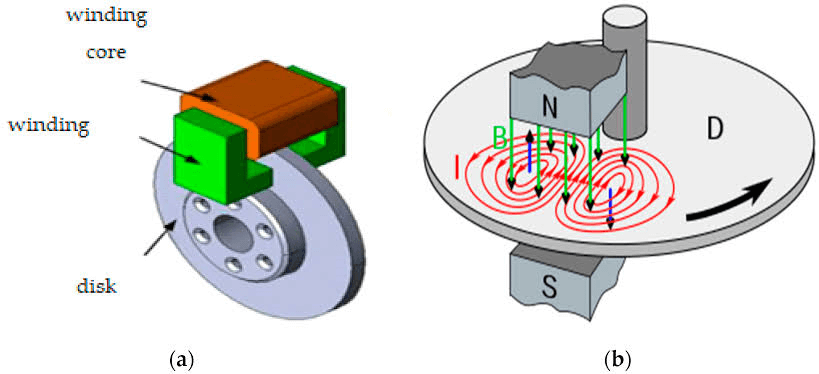
Through the application of eddy current brakes, moving objects can be slowed down or stopped. No mechanical wear results from the absence of touch with a disc brake or drum. Eddy current brakes, on the other hand, are incapable of producing a "holding" torque and can therefore be employed in conjunction with electromechanical brakes, for instance on overhead cranes. Heavy copper plates protruding from the car are moved between two pairs of extremely powerful permanent magnets in another application found on some roller coasters. The kinetic energy of the car is lost due to a dragging effect caused by electrical impedance within the plates that is comparable to friction. The same method is utilized in electromagnetic brakes on railroad wagons and in power equipment like circular saws to instantly halt the blades. In contrast to permanent magnets, electromagnets allow the magnetic field's intensity to be modified, so altering how much of a braking effect is produced. 2. Repulsive Effects and Levitation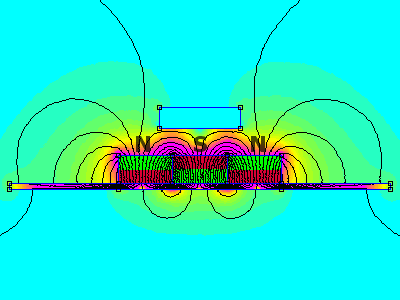
The effects of the induced currents resemble diamagnetic repulsion in a changing magnetic field. An object that conducts electricity will feel a repelling force. With constant power input to replenish the energy lost by the eddy currents, this can raise objects against gravity. One eddy current separator application is the separation of aluminium cans from other metals. Aluminum and other non-ferrous conductors have been pushed away from the magnet, which can separate wastewater into ferrous and non-ferrous scrap steel. Ferrous metals cling to the magnet whereas aluminium and other non-ferrous conductors cling to the magnet. One may readily see a very similar impact by swiftly brushing a portable magnet, such as one made of neodymium, over a coin with a very small separation. Even if the coin doesn't include any magnetic components, like the US penny, one can still cause it to be pulled marginally ahead of the magnet depending on the magnet's strength, the coin's identity, and the distance between them. Another illustration involves putting a powerful magnet dramatically slow down a copper tube. 3. Metals IdentificationEddy currents are sometimes utilised in coin-operated vending machines to identify fake coins, or "slugs." Eddy currents cause a coin to move more slowly as it passes by a magnet that isn't moving. The conductance of a coin's metal determines how strong the eddy currents are and how much retardation results. Slugs are sent into the rejection slot because they are slowed down differently than real coinage. 4. Position and Vibration Detection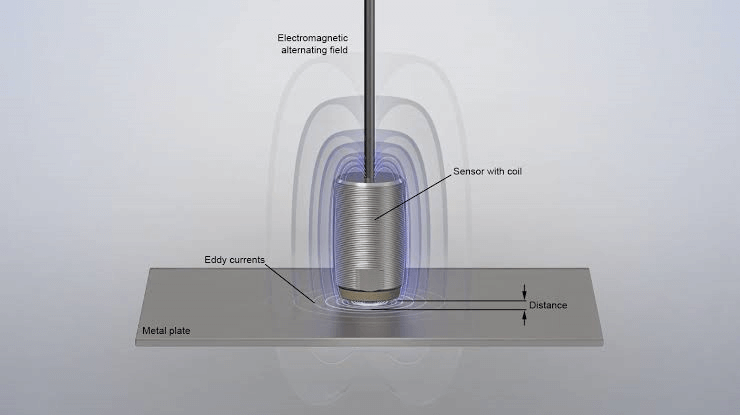
In some varieties of proximity sensors, eddy currents are employed to track the movement and vibration of spinning shafts inside their bearings. Researchers at General Electric invented this technology in the 1930s using Hoover tube electronics. Donald E. Bently created solid-state versions at Bently Nevada Corporation in the late 1950s. These sensors are particularly adapted for observing the minute vibrations (on the order from several thousandths of an inch) in contemporary turbomachinery because they are exceedingly responsive to very small displacements. The common scale factor for a proximity sensor used for vibration measurements is 200 mV/mil. Due to the widespread usage of these sensors in turbomachinery, the industry has developed standards that outline how they should be used. These standards include ISO 7919 and American Petroleum Institute (API) Standard 670, for instance.
Next TopicElectrical Energy Definition
|
 For Videos Join Our Youtube Channel: Join Now
For Videos Join Our Youtube Channel: Join Now
Feedback
- Send your Feedback to [email protected]
Help Others, Please Share









